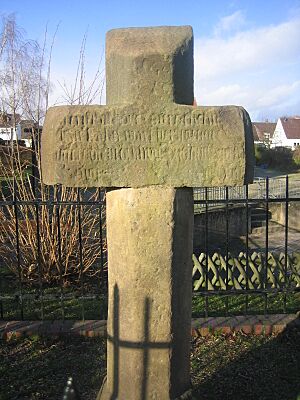Frederick I, Duke of Brunswick-Wolfenbüttel facts for kids
Quick facts for kids
Frederick I
|
|
|---|---|
| Duke of Brunswick-Lüneburg | |
| Prince of Brunswick-Wolfenbüttel | |
| Reign | 1373–1400 |
| Born | c. 1357 |
| Died | 5 June 1400 Kleinenglis, Waldeck |
| Noble family | House of Welf |
| Spouse(s) | Anna of Saxe-Wittenberg |
| Father | Magnus II, Duke of Brunswick-Lüneburg |
| Mother | Catherine of Anhalt-Bernburg |
Frederick I (born around 1357 – died June 5, 1400) was an important duke from the House of Welf. He ruled as the Duke of Brunswick-Lüneburg and Prince of Brunswick-Wolfenbüttel from 1373 until his death. In May 1400, he tried to become the German king but was not chosen. Sadly, he was murdered on his way home.
Contents
Early Life and Rule as Duke
Frederick was the oldest son of Duke Magnus II of Brunswick-Lüneburg. His mother was Catherine of Anhalt-Bernburg. When his father died in 1373, Frederick was still young. He officially became an adult ruler in 1381. Before that, Duke Otto of Brunswick-Göttingen helped guide him.
Ending the Lüneburg Succession War
Like his father, Frederick was involved in the Lüneburg Succession War. This was a long fight over who would rule the Principality of Lüneburg. In 1373, Frederick and his brothers tried to end the war with a peace treaty. They made an agreement with the dukes from the Ascanian family of Saxe-Wittenberg. This treaty said that the two families would take turns ruling Lüneburg.
However, the fighting continued for many years. Frederick and his brothers kept fighting for their family's claim. They finally won the war in 1388. This happened when they successfully captured the city of Lüneburg itself.
The Royal Election of 1400
In May 1400, Frederick went to a big meeting in Frankfurt. This meeting was for the most powerful princes of the Holy Roman Empire. The main goal was to discuss removing the current king, King Wenceslaus, who was seen as not doing a good job.
Frederick's Candidacy for King
Some people believe that Frederick's brother-in-law, Duke Rudolf III of Saxe-Wittenberg, suggested Frederick as a new king. This would have made him an "anti-king" to Wenceslaus. However, other princes preferred Rupert of the Palatinate. Since they could not agree on who to choose, Frederick left the meeting.
Today, historians are not sure if Frederick was truly a strong candidate. There are no official papers that prove he was elected or even seriously considered. King Wenceslaus was eventually removed from power on August 20, 1400. Rupert was then chosen as the new King of the Romans the very next day.
Frederick's Tragic Death
What is certain is that Frederick was murdered on his way home from the meeting. He was killed by Count Henry VII of Waldeck and his helpers. These helpers included Friedrich von Hertingshausen and Konrad von Falkenberg. Some people think the murder happened to get rid of a possible king. Others think the story of him being a royal candidate was made up later to explain why he was killed.
Frederick's murder caused a lot of shock at the time. A special stone cross, called a Kaiserkreuz, was put up where he died. This cross is in Kleinenglis, near Fritzlar. The new King Rupert ordered the murderers to donate an altar to Saint Peter's Church, Fritzlar. This was their punishment for the crime. Frederick was buried in Brunswick Cathedral.
Family Life
In 1386, Frederick married Anna. She was the daughter of Duke Wenceslaus I of Saxe-Wittenberg. Anna passed away in 1388.
Frederick and Anna had two daughters:
- Catherine (died around 1439): She married Henry XXIV, Count of Schwarzburg-Sondershausen.
- Anna (died 1432): She married the Habsburg duke Frederick IV of Austria. He was also known as "Frederick of the Empty Pockets" and was the Count of Tyrol.


